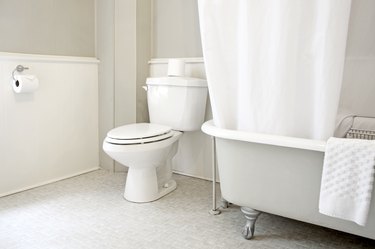
Four-bolt toilets are a thing of the past, so if you have an old one that isn't working, you'll have to replace it with a two-bolt model. You shouldn't have any difficulty, because the same two bolts connect the toilet to the flange on both types of toilets. The two extra bolts in the older models are usually screwed to the floor. After you remove the old toilet, make sure the flange is at the correct distance from the walls to accommodate the new toilet, and that it is corrosion-free and at the appropriate height. You should also check the condition of the subfloor. That four-bolt toilet was probably there for a while, and it had lots of chances to leak. If it did, you may notice rot on the floor that you'll need to fix.
Why a 4-Bolt Toilet?
Video of the Day
Manufacturers largely stopped making the 4-bolt toilet in the 1960s. The idea behind it was simple: If two bolts can hold a toilet securely, four bolts are even more secure. Two of the bolts hold the toilet to the flange, just as they do for modern toilets. The other two bolts simply screw into the floor to make double sure the toilet doesn't go anywhere. You can simply ignore those two extra holes in the floor, or you can fill them with putty, when you remove the toilet. The hardest part of the job may be getting the bolts out, because they might have rusted. If so, you may have to cut them off with a hacksaw.
Video of the Day
Do I Need to Modify Anything?
You probably won't need to make any modifications. When you get the old toilet off, you'll find a flange with the standard bolt spacing that will fit a modern toilet. The flange is likely to be made of cast iron, not plastic. That isn't a problem as long as the metal hasn't corroded. If it has, it might not hold the toilet bolts, and you'll find the new toilet lifts off the floor. Replacing an old toilet flange is usually a job for a plumber, but you may be able to repair the flange with a repair ring, which you can find at any hardware or plumbing supply store.
Another problem you might encounter is that the four-bolt model may be an 11 rough-in toilet, which would mean that the opening is a little too close to the back wall to accommodate a standard 12-inch rough-in model. If so, you can find 10-inch rough-in toilets designed for small spaces, and you may have to use one of those.
The Retrofit Procedure
Before you remove the old toilet, turn off the water and drain both the tank and bowl with a sponge or a turkey baster. Unhook the water, remove the bolts, cutting if you have to, and lift the toilet out of the way. Throw away the old toilet bolts and clean all the old wax with a putty knife. Set two new bolts in the flange, place a wax ring on the bottom of the new toilet and set it in place. Sit on it to spread the wax, then tighten down the bolts, hook up the water and fill the tank. Flush once or twice to test the float level, adjusting as needed. When the tank fills to within an inch of the top of the overflow tube, the toilet is ready for customers.